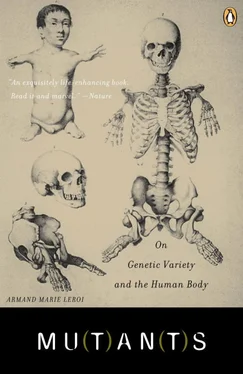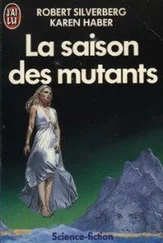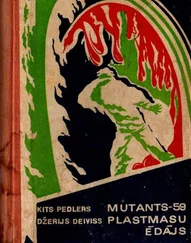It is a diagnosis that allows us to reconstruct something of the old soldier’s medical history. Although the immediate cause of his death is not known, it certainly had nothing to do with his inverted viscera. He was, indeed, in all likelihood oblivious to his own internal peculiarities. Although he was quite healthy (dying only at the age of seventy-two), he probably never fathered any children, and his sense of smell was also probably quite poor. We can guess these things because inverted viscera, sterility and a weak sense of smell are all features of men with Kartagener’s.
That the association between these symptoms was ever noticed is surprising, for they seem so disparate, and even after the syndrome was first defined in 1936 the causal link between them remained elusive for years. But in 1976 a Swedish physician named Bjorn Afzelius found that a poor sense of smell and sterility are caused by defective cilia – the minute devices that project from the surfaces of cells and wave about like tiny oars. Cilia clear particles from our bronchial passages, and the tail that drives a spermatozoon to its destination is also just a large sort of cilium. Each cilium is driven by a molecular motor, a motor that in people with Kartagener’s syndrome does not work. As children, for want of beating cilia to clear the passages of their lungs and sinuses they have chronic bronchitis and sinusitis – hence the poor sense of smell. As adults, the men are sterile for want of mobile sperm. At the heart of the ciliary motor lies a large protein complex called dyenin. It is made up of a dozen-odd smaller proteins, each of which is encoded by its own gene. So far Kartagener’s syndrome has been traced to mutations in at least two of these genes, and it is certain that others will be found.

KARTAGENER’S SYNDROME. DISSECTED INFANT SHOWING SITUS INVERSUS VISCERA. FROM GEORGE LECLERC BUFFON 1777 HISTOIRE NATURELLE GÉNÉRALE ET PARTICULIÈRE.
But it is the situs inversus that is so intriguing. Afzelius noted that not all people with Kartagener’s syndrome have inverted viscera: like conjoined twins, only half of them do. He suggested, insightfully, that this implied that cilia were a vital part of the devices that the embryo uses to tell left from right – but what their role was he could not say. Only in the last few years has the final link been made – and even now there is much that is obscure. It all has to do with (and this is no surprise) the organiser.
I said earlier that the organiser is a group of mesodermal cells located at one end of the embryo’s primitive streak. Each of these cells has a single cilium that beats continually from right to left. Collectively they produce a feeble, but apparently all-important, current in the fluid surrounding the embryo, an amniotic Gulf Stream. This directional movement, and the cilia whose ceaseless activity causes it, is the first sign that left and right in the embryo are not the same. The mechanism, which was only discovered in 1998, is wonderfully simple and, as far as is known, is used nowhere else in the building of the embryo. What the cilia actually do is unclear; the best guess is that they concentrate some signalling molecule on the left side of the embryo, rather as foam accumulates in the eddies of a river.
This model (with its Aristotelian overtones) is frankly speculative, but it makes sense in the light of what happens next. Shortly after the organiser forms, genes can be seen switching on and left and right in the cells that surround it. They encode signalling molecules that transmit and amplify the minute asymmetries established by the organiser’s beating cilia to the rest of the embryo. One might call it a relay of signals, but that suggests something too consensual. It is more like a hotly contested election. In democracies left and right battle for the heart of the polis ; so it is in embryos as well.
There is a lovely experiment that proves this. If the various signals that appear early in the embryo’s life on either side of the organiser are indeed involved in helping it tell left from right, then it should be possible to confuse the embryo by switching the signals around. As usual, this is a hard trick to do in mammal embryos, but not that difficult in chickens. By gently cutting open a recently-laid egg and so exposing the embryo as it lies on its bed of yolk, it is possible to gently place a silicone bead soaked in ‘left-hand’ signal on its right (or to place a bead soaked in ‘right-hand’ signal on its left). Either way, the asymmetry of the embryo’s signals is destroyed. And so too, it becomes apparent shortly thereafter, is the asymmetry of the chicken’s heart. Where once it always fell to the left, it now has an even probability of falling to either side. The resemblance of this randomisation to that found in people with Kartagener’s syndrome and in conjoined twins is surely no coincidence. Indeed, it is thought that Ritta’s inverted heart was caused by just such a scrambled molecular signal. When the girls were nothing more than primitive streaks lying side by side, each strove to order her own geometry. But in Ritta’s case this effort was confounded by signals that swept over from her left-hand twin. The molecular asymmetries upon which her future geometry depended were abolished, and from that point on the odds were fifty–fifty that her heart would be placed the wrong way round.
In 1974 Clara and Altagracia Rodriguez became the first conjoined twins to undergo successful surgical separation. Since then, the birth of each new pair – Mpho and Mphonyana (b.1988, South Africa), Katie and Eilish (b.1989, Ireland), Angela and Amy (b.1993, USA), Joseph and Luka (b.1997, South Africa), Maria Teresa and Maria de Jésus (b.2002, Guatemala), to name but a few – has been the occasion of a miniature drama in which surgeons, judges and parents have been called upon to play the part of Solomon. Surgical advances nothwithstanding, had Ritta and Christina Parodi been born today they could not have been separated. But they would surely have lived. Somewhere in America, Brittany and Abigail Hensel, twins even more closely conjoined than they, have recently turned twelve.
Jules Janin never wrote his novel of Ritta and Christina Parodi’s unlived lives. But he did leave an outline of what he had in mind. No translation could do justice to the turbulence of his prose, but a paraphrase gives an idea. In Janin’s world, far from being born to poverty (after all, ‘ la misère gâte tout ce qu’elle touche ’), the two girls are rather well off. They also, inexplicably, have different-coloured hair. Christina, who is blonde, strong and noble, watches tenderly over her weaker, slightly sinister sibling, who is, inevitably, the brunette. All is harmonious, but suddenly seventeen springs have passed and, arrive l’Amour , in the shape of a bashful Werther who loves, and is loved by, only one of them – Christina, of course. Ah, the paradox! Two women, one heart, one lover; it is too tragic for words. Ritta sickens, and a mighty struggle between life and death ensues, as when un guerrier est frappé à mort . The sisters expire and we leave them having, as Janin puts it, ‘arrived at new terrors, unknown emotions’, and a sense of relief that he never wrote the full version.
The reality was, of course, quite different. When Serres had done with Ritta and Christina he not only kept the skeleton but quite a few other body-parts as well. An old catalogue of the Muséum d’Histoire Naturelle lists, in a copperplate hand, separate entries for the infants’ brains (Cat. No. 1303 and 1304), eyes (1306, 1307), tongues (1308, 1309) and various other bits and pieces. Most of these specimens now seem to be lost, though it is possible that they will one day surface from the museum’s underground vaults. Ritta and Christina’s skeleton, however, is still around – as is the painted plaster-cast of their body. Both are on display in the Gallery of Comparative Anatomy, a steel-vaulted structure with an interior like a beaux-arts cathedral that stands only a few hundred metres from the amphitheatre where the sisters were first dissected.
Читать дальше













